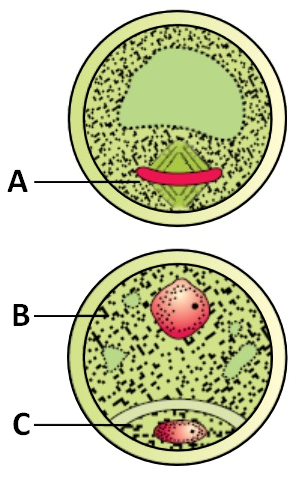Which among the following is not a feature of pistil?
(1) Monocarpellary
(2) Syncarpous
(3) Monosporic
(4) Apocarpous
Cryopreservation is a technique to preserve substances like pollen grains in liquid nitrogen at temperature
(1) –150 °C
(2) 77.15 K
(3) –210 °C
(4) 110 K
A, B, C, D in the following diagram respectively are:-
(1) Hilum, funicle, inner integument, micropyle
(2) Hilum, funicle, outer integument, micropyle
(3) Funicle, outer integument, nucellus, chalazal pole
(4) Funicle, outer integument, nucellus, micropylar end
Microsporangium is generally surrounded by 4 wall layers. Which of the following 3 wall layers perform the function of protection and help in the dehiscence of anther to release the pollen?
(1) Epidermis, tapetum, endothecium
(2) Epidermis, aril, endothecium
(3) Epidermis, endodermis, mesocarp
(4) Epidermis, middle layer and endothecium
Which of the following points is incorrect about sporopollenin?
(1) It is one of the most resistant organic material known
(2) It can withstand high temperature and strong acids and alkali
(3) 2 enzymes that degrade sporopollenin are known so far
(4) Pollen grains are well preserved as fossils because of presence of sporopollenin

The above diagram shows some stages in microgametogenesis. Identify A, Band C:
1. A: Symmetric spindle, B: Generative cell, C: Vegetative cell
2. A: Symmetric spindle, B: Vegetative cell, C: Generative cell
3. A: Asymmetric spindle, B: Vegetative cell, C: Generative cell
4. A: Asymmetric spindle, B: Generative cell, C: Vegetative cell
Which of the following statements is false?
| I. | Pollen grains represents male gametophyte |
| II. | In angiosperms partially developed male gametophytes are pollinated |
| III. | Generative cell is siponogenous while vegetative cell is spermatogenous |
| IV. | Formation and differentiation of pollen grains is called microsporogenesis |
| V. | Hay fever is a pollen allergy |
| VI. | Pollen grains of some plants produce severe allergy and respiratory or bronchial diseases |
| VII. | Pollen grains are poor in nutrients. |
1. I and VII
2. III and VII
3. IV and V
4. VI and VII
The viability of pollen grains depends upon:
(1) Prevailing temperature
(2) Prevailing humidity
(3) Genetic potentiality of the concerned species
(4) All of the above
Which of the following has the least pollen viability?
(1) Cereals like wheat and rice
(2) Members of Rosaceae
(3) Members of Leguminoseae
(4) Members of Solanaceae
Match the Column-I with Column-II:
Column-I Column-II
A. Funicle I. Mass of cells within ovule with more food
B. Hilum II. Basal part of ovule
C. Integument III. One or 2 protective layers of ovule
D. Chalaza IV. Region where body of ovule fuses with funicle
E. Nucellus V. Stalk of ovule
(1) A - I, B - II, C - III, D - IV, E - V
(2) A - V, B - IV, C - III, D - II, E - I
(3) A - IV, B - II, C - I, D - III, E - V
(4) A - I, B - III, C - V, D - II, E - IV







